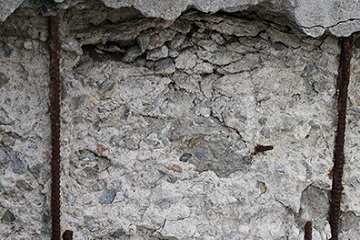Table of Contents
What Is Concrete Spalling?
Concrete spalling is an incident in which concrete breaks itself and is free from structure. In concrete spalling, reinforcement bars are exposed to the atmosphere.
The initial phase of the spalling problem does not look much serious but when bigger parts break and are free from structure then it creates a problem.

In this concept, concrete is broken away from its surface. It further extends to the top layers of reinforcing steel. Concrete spalls can be 150 millimeters or more in diameter and 25 millimeters or more in-depth. Development of smaller spalls is also possible as per American Concrete Institute (ACI 302.1R-4).
Spalling of concrete influences a broad variety of constructions including framed structures, multi-story vehicle parks, and bridges. It makes the concrete surface patchy and pitted while exposing aggregate underneath. As soon as spalling is spotted, it should be properly repaired otherwise it compromises concrete surface integrity and jeopardizes the ultimate capacity of the member. It also affects the aesthetic appearance of the structure.
Main Factors Causing Spalling Of Concrete
- Corrosion in reinforcement bar.
- Excessive moisture due to atmospheric conditions.
- Alkali element in concrete.
- Sulfate attack.
- Acid rain.
How To Prevent Concrete Spalling
- Provide adequate concrete cover.
- Avoid accessive water content.
- Application of good water sealant on the concrete surface.
- By using the epoxy-coated bar.
Procedure To Repair Spalled Concrete
- Clean spalled concrete.
- Remove loose concrete.
- Surface Chipping.
- Clean rebar.
- Concrete casting.
- Application of curing compound or water curing.
- Painting.
Difference Between Concrete Spalling And Concrete Scaling
I made a detailed table to differentiate between concrete spalling and concrete scaling.
| Concrete Spalling | Concrete Scaling |
|---|---|
| It is when the top layer of the concrete peels off in small pieces. | It is when the top layer of the concrete flakes off in larger pieces. |
| It can be caused by water getting into the concrete and freezing. | It can be caused by using too much water when the concrete is mixed. |
| It makes the surface of the concrete rough and bumpy. | It makes the surface of the concrete look like it has scales. |
| It usually happens in small areas. | It can happen in large areas. |
| It can happen on floors, walls, and ceilings. | It can happen on floors and walls. |
| It can make the concrete look like it has potholes. | It can make the concrete look like it has big patches missing. |
| It can be fixed by chipping away the loose concrete and then patching the area. | It can be fixed by grinding down the surface of the concrete and then resurfacing it. |
| It can be prevented by using a sealer on the surface of the concrete. | It can be prevented by using the right amount of water when mixing the concrete. |
| It is more common in colder climates. | It can happen in any climate. |
| It can happen to old or new concrete. | It can happen to new concrete. |
| It can be dangerous if it happens on a staircase or walkway. | It can be dangerous if it happens on a staircase or walkway. |
| It is a type of damage that can happen to concrete. | It is a different type of damage that can happen to concrete. |
| It is important to fix it to prevent further damage. | It is important to fix it to prevent further damage. |
| It can be caused by heavy traffic or machinery. | It is usually not caused by heavy traffic or machinery. |
| It can happen to any type of concrete surface. | It can happen to any type of concrete surface. |
| It can be caused by using the wrong type of concrete for the job. | It is not caused by using the wrong type of concrete for the job. |
| It is more common in older concrete. | It is more common in newer concrete. |
| It can be caused by using salt to melt ice on the concrete. | It is not caused by using salt to melt ice on the concrete. |
| It is important to keep concrete surfaces clean to prevent it. | It is important to use the right amount of water when mixing concrete to prevent it. |
| It can happen to any thickness of concrete. | It can happen to any thickness of concrete. |
Faqs
Yes, concrete spalling can be dangerous as it can compromise the structural integrity of the concrete surface, leading to potential collapse or other safety hazards.
No, concrete scaling is not the same as concrete cracking. Scaling refers to the flaking of the surface layer, while cracking refers to the formation of cracks in the concrete.
De-icing salt can contribute to concrete spalling and scaling by penetrating the surface of the concrete and reacting with the material, causing it to expand and contract, leading to cracking and the flaking off of the surface layer.
Yes, using a sealer can help to prevent or minimize the effects of concrete spalling and scaling by creating a barrier between the concrete surface and the environmental factors that cause the deterioration.
Concrete surfaces should be inspected regularly for signs of spalling and scaling, especially in areas that are exposed to environmental factors such as freeze-thaw cycles or de-icing salts. The frequency of inspections will depend on the specific conditions and intended use of the concrete surface.
